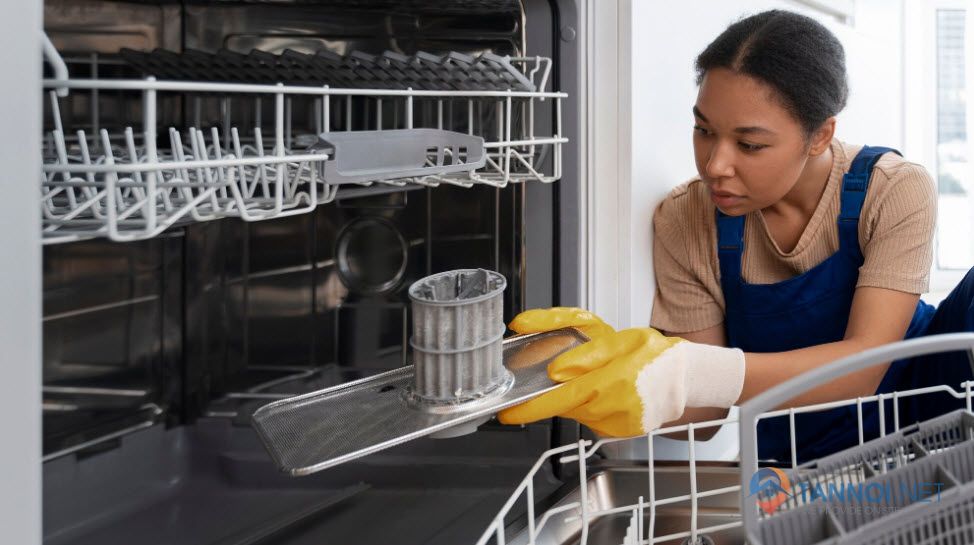In today’s fast-paced world, maintaining a clean and healthy home is more important than ever. Whether you’re a homeowner or a professional cleaning service provider, understanding the best practices for cleaning homes is essential. This comprehensive guide explores the ins and outs of cleaning homes, with a focus on effective strategies, eco-friendly options, and safety tips. We’ll delve into the importance of a clean living space, share expert advice, and offer practical solutions to ensure your home is a safe and comfortable environment for you and your loved ones. So, let’s roll up our sleeves and get started on the journey to a spotless and inviting home.
Chapter 1: The Significance of Cleaning Homes
A clean home is not just about aesthetics; it plays a crucial role in the health and well-being of its occupants. The significance of a clean home extends beyond the visual appeal. Here are some compelling reasons why maintaining a cleaning homes is essential:
1. Improved Air Quality: One of the primary benefits of a clean home is the enhancement of indoor air quality. Regular cleaning reduces the accumulation of dust, allergens, and pollutants that can linger in the air. This is especially important for individuals with allergies or respiratory issues. Clean air promotes better respiratory health and overall well-being.
2. Allergen Reduction: Cleaning homes can harbor a variety of allergens, including dust mites, pet dander, and pollen. These allergens can trigger allergic reactions and worsen conditions like asthma. Thorough and regular cleaning helps reduce allergen levels, making your home a more comfortable and safe environment for everyone.
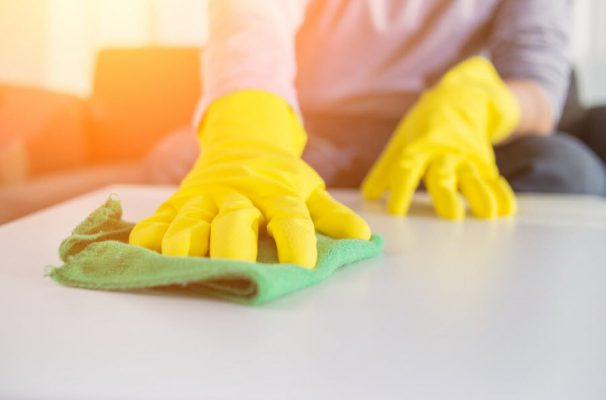
3. Enhanced Mental Well-being: A clean and organized living space can have a positive impact on your mental health. Clutter and mess can lead to stress and anxiety, while a tidy home promotes a sense of calm and order. It’s easier to relax and focus in a clean environment, contributing to mental well-being.
4. Reduced Disease Transmission: cleaning homes are less likely to harbor harmful bacteria and viruses. Proper cleaning and disinfection, especially in high-touch areas like kitchens and bathrooms, can help reduce the risk of illness transmission among household members.
5. Extended Lifespan of Belongings: Regular cleaning and maintenance can prolong the lifespan of your belongings. For example, dust and dirt can accumulate on surfaces, leading to wear and tear over time. By cleaning and caring for your possessions, you can save money on replacements.
6. Improved Productivity: A clean home can boost productivity and creativity. When your surroundings are organized and clutter-free, you’re more likely to feel motivated and focused on tasks. It’s easier to find what you need, leading to increased efficiency.
7. Positive Impressions: A clean and well-maintained home leaves a positive impression on guests and visitors. It reflects your attention to detail, responsibility, and respect for your living environment.
In conclusion, the significance of cleaning homes goes far beyond aesthetics. A clean home contributes to improved air quality, reduced allergens, enhanced mental well-being, lower disease transmission risks, longer-lasting belongings, increased productivity, and positive impressions. By prioritizing cleanliness, you’re not only creating a comfortable living space but also investing in the health and happiness of your household.
Chapter 2: Essential Cleaning Supplies and Tools
To effectively clean your home, you need a well-stocked arsenal of essential cleaning supplies and tools. These items not only make your cleaning tasks easier but also ensure thorough cleaning. Let’s delve into the must-haves for every home:
1. Cleaning Agents: Start with a selection of cleaning agents for various surfaces. This includes all-purpose cleaners, glass cleaners, bathroom cleaners, and kitchen cleaners. Choose eco-friendly options when possible to minimize environmental impact.
2. Microfiber Cloths: Microfiber cloths are highly effective at capturing dust and dirt. They’re reusable, which makes them eco-friendly, and they work well for wiping and scrubbing various surfaces without leaving streaks or lint.
3. Broom and Dustpan: For quick floor sweeps and collecting dirt and debris, a broom and dustpan are indispensable. They’re excellent for hardwood, tile, and other hard surfaces.
4. Mop and Bucket: A mop and bucket are essential for thoroughly cleaning hard floors. Look for a mop with a removable, machine-washable head for convenience.
5. Vacuum Cleaner: A reliable vacuum cleaner is a must for cleaning homes with carpets and rugs. Choose a vacuum with adjustable settings for different floor types, and don’t forget to clean or replace the filters regularly.
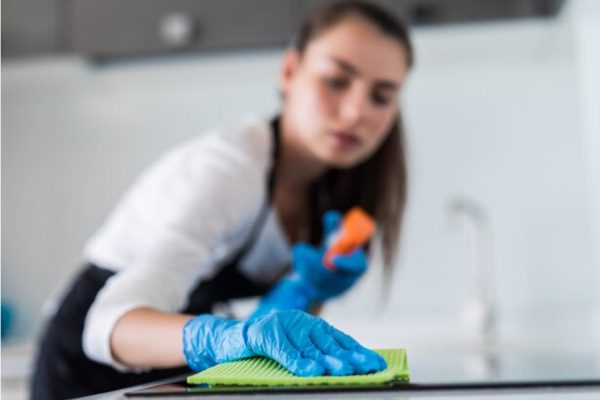
6. Scrub Brushes: Scrub brushes with various bristle types are helpful for tackling tough stains and grime on surfaces like tiles, grout, and stovetops.
7. Sponges: Sponges are versatile tools for both scrubbing and wiping. Opt for scrubbing sponges for more challenging tasks and soft sponges for delicate surfaces.
8. Rubber Gloves: Protect your hands from harsh cleaning homes chemicals and hot water with sturdy rubber gloves. They also provide a better grip when handling wet or slippery items.
9. Trash Bags: Quality trash bags are essential for keeping waste contained and making it easy to dispose of garbage. Select the right size and strength for your needs.
10. Disinfecting Wipes: In high-touch areas like the kitchen and bathroom, disinfecting wipes come in handy for quick cleanups and sanitization.
11. Extension Duster: An extension duster with a long handle is perfect for reaching high or hard-to-access areas, such as ceiling fans, light fixtures, and top shelves.
12. Window Cleaning Tools: For crystal-clear windows and mirrors, consider window cleaning homes tools like a squeegee and a bucket with a window cleaning solution.
13. Trash Bins and Liners: Regularly clean and sanitize your trash bins and ensure you have a stock of liners for easy disposal.
Having these essential cleaning homes supplies and tools on hand will streamline your cleaning homes process and ensure that you’re equipped to tackle various cleaning homes tasks throughout your home.
Chapter 3: Room-by-Room Cleaning Guide
Cleaning homes your home room by room ensures that you address specific challenges and tailor your approach to each space. Let’s explore the best cleaning homes practices for each area of your home:
3.1. Kitchen Cleaning
The kitchen is a hub of activity and can accumulate dirt and grease quickly. To maintain a clean and hygienic kitchen:
1. Clear Countertops: Start by clearing countertops of appliances and dishes. This gives you access to all surfaces.
2. Wipe Down Countertops: Use an appropriate kitchen cleaner to wipe down countertops, backsplashes, and cabinet fronts. Pay special attention to areas near the stove and sink, where grease and food splatters are common.
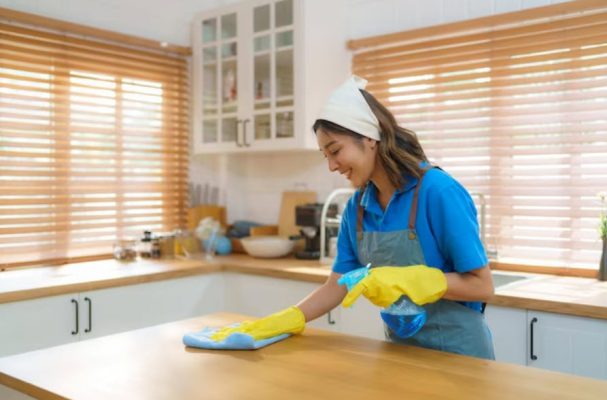
3. Clean Appliances: Clean the exterior of appliances such as the refrigerator, microwave, and dishwasher. Remove and clean any removable parts, like microwave trays and refrigerator shelves.
4. Degrease Stovetop: For gas or electric stovetops, remove burner grates and knobs and clean them thoroughly. For smooth-top ranges, use a glass cooktop cleaner.
5. Sink and Garbage Disposal: Scrub the sink with a suitable cleaner and dispose of any food residue. Freshen the garbage disposal by running ice cubes and citrus peels through it.
6. Organize the Pantry: Take this opportunity to declutter and organize your pantry. Dispose of expired items and wipe down shelves.
7. Empty and Clean the Trash Bin: Empty the trash and recycling bins, and clean them to prevent odors.
8. Floor Cleaning: Finish the kitchen cleaning homes by sweeping or vacuuming the floor, followed by mopping. Choose a floor cleaner suitable for your flooring type.
3.2. Bathroom Cleaning
Bathrooms require thorough cleaning homes to maintain hygiene and prevent mold and mildew growth. Follow these steps for a sparkling clean bathroom:
1. Declutter: Begin by removing items from countertops, shelves, and the shower or bathtub. This allows you to access all surfaces.
2. Disinfect High-Touch Areas: Disinfect high-touch areas like faucets, doorknobs, and light switches. Use a bathroom-specific cleaner to tackle soap scum and water spots.
3. Clean the Toilet: Clean and disinfect the toilet bowl, seat, and exterior. Don’t forget to wipe down the flush handle.
4. Shower and Bathtub: Scrub the shower or bathtub, paying attention to tiles, grout, and glass doors. Use a mold and mildew cleaner if needed.
5. Mirror and Vanity: Clean mirrors and wipe down the vanity. Use a glass cleaner for a streak-free shine.
6. Shower Curtain and Liner: If you have a fabric shower curtain or liner, check the care instructions for washing. Plastic liners can be wiped down or replaced if necessary.
7. Organize and Restock: Take a moment to organize toiletries and restock items like toilet paper and hand soap.
8. Floor Cleaning: Sweep or vacuum the bathroom floor, and then mop it with a suitable floor cleaner.
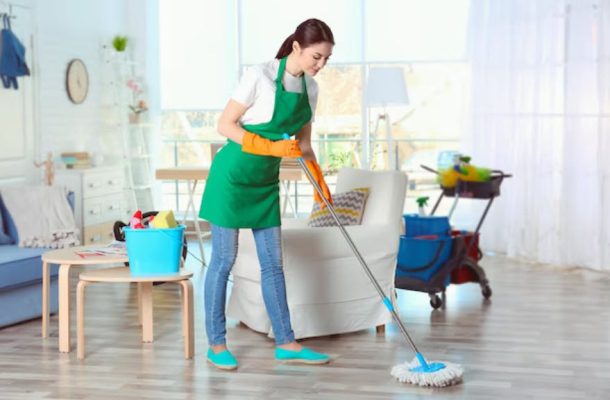
3.3. Living Room and Bedrooms
Living rooms and bedrooms are spaces for relaxation and comfort. Keep them clean and inviting:
1. Dusting: Begin by dusting all surfaces, including shelves, electronics, and decor. Use a microfiber cloth or duster to capture dust effectively.
2. Vacuuming: Vacuum carpets, rugs, and upholstery. Pay special attention to high-traffic areas and under furniture.
3. Upholstery and Fabric Care: Spot clean any stains or spills on upholstery or fabric surfaces. Follow the care instructions on the furniture, cleaning homes.
4. Window Treatments: Dust or vacuum curtains and blinds. If they’re machine washable, consider washing them.
5. Declutter: Take a moment to declutter and organize the living room and bedrooms. Return items to their proper places.
6. Linens and Bedding: Change bed linens, pillowcases, and duvet covers. If applicable, wash and replace curtains and throw blankets.
7. Floors: Finish by sweeping or vacuuming the floors and then mopping as needed.
3.4. Floors and Carpets
Your floors endure a lot of wear and tear, but proper care can extend their lifespan and keep them looking their best:
1. Sweep and Vacuum: Start by sweeping hard floors to remove loose dirt and debris. Vacuum carpets, rugs, and upholstery to capture dust and pet hair.
2. Spot Cleaning: For stains on carpets or upholstery, use a suitable stain remover. Follow the product instructions for the best results.
3. Mop Hard Floors: Use a mop and appropriate floor cleaner to clean hard floors. Pay attention to the manufacturer’s recommendations for your specific flooring type, whether it’s tile, hardwood, laminate, or vinyl.
4. Carpet Cleaning: Periodically, consider deep carpet cleaning homes to remove embedded dirt and odors. You can rent a carpet cleaner or hire a professional carpet cleaning service.
5. Floor Mats: Place floor mats at entryways to reduce the amount of dirt and moisture brought into your home. Clean and shake out mats regularly.
6. Furniture Protection: Use furniture pads under heavy furniture to prevent scratches and dents on your floors.
By following this room-by-room cleaning homes guide, you can ensure that each area of your home receives the specific attention it needs. Whether it’s the kitchen, bathroom, living room, or bedroom, these thorough cleaning homes steps will keep your home in top shape.
Chapter 4: Eco-Friendly Cleaning
Eco-friendly cleaning practices are not only better for the environment but also healthier for you and your family. Here are some eco-friendly cleaning options and practices to consider:
1. Natural Cleaning Agents: Many common household items can serve as effective, eco-friendly cleaning agents. Vinegar, baking soda, lemon juice, and hydrogen peroxide can be used for various cleaning tasks.
2. Eco-Friendly Cleaning Products: Look for cleaning products labeled as environmentally friendly, non-toxic, and biodegradable. These products have a lower impact on the ecosystem.
3. Reusable Cleaning Tools: Instead of disposable cleaning wipes and paper towels, opt for reusable cleaning cloths and microfiber towels. They are washable and long-lasting.
4. Reduce Plastic Waste: Choose cleaning product containers that can be refilled or use concentrated cleaning solutions to reduce plastic waste.
5. Homemade Cleaners: Create your own homemade cleaning solutions with simple ingredients like vinegar and water. For example, a mixture of vinegar and water is excellent for cleaning glass surfaces.
6. Low-Waste Cleaning Practices: Minimize waste by using washable mop pads, scrub brushes with replaceable heads, and durable cleaning tools that can be used for years.
7. Natural Scents: To freshen your home, consider using natural scents like essential oils or fresh herbs. Simmering water with citrus peels and spices can create a pleasant, natural fragrance.
8. Green Pest Control: Instead of chemical pesticides, explore natural methods for pest control. For example, use diatomaceous earth for ant prevention.
9. Conserving Water: Be mindful of water usage during cleaning. Turn off the tap when not in use, and use a bucket or basin for water instead of running it continuously.
10. Sustainable Disposal: Dispose of cleaning waste responsibly. Recycle containers and properly dispose of cleaning materials that may be hazardous.
By incorporating eco-friendly cleaning practices into your routine, you can reduce your environmental footprint and promote a healthier living space for you and your family.
Chapter 5: Safety Considerations
Safety should always be a top priority when cleaning your home. Here are important safety considerations to keep in mind:
1. Ventilation: When using cleaning products, ensure good ventilation in the area you’re cleaning. Open windows and doors to allow fresh air to circulate.
2. Protective Gear: Wear protective gear, such as gloves and eye protection, when handling cleaning agents. This is particularly important when dealing with chemicals.
3. Label Awareness: Read and follow the instructions on cleaning product labels. This includes dilution ratios, safety precautions, and proper usage.
4. Child and Pet Safety: Store cleaning products out of reach of children and pets. Many cleaning agents can be harmful if ingested or touched.
5. Chemical Mixing: Avoid mixing different cleaning agents unless the label explicitly states that it’s safe to do so. Mixing certain chemicals can produce harmful fumes.
6. Slip and Fall Prevention: Be cautious about slippery surfaces after cleaning. Use warning signs or block off areas where floors are wet until they dry.
7. First Aid Knowledge: Familiarize yourself with first aid procedures in case of accidental exposure to cleaning agents. Keep a first aid kit on hand.
8. Safe Storage: Store cleaning products in a cool, dry place away from direct sunlight and heat sources. Keep products in their original containers and label them clearly.
9. Electrical Safety: When cleaning homes near electrical outlets or appliances, be mindful of water and electrical safety. Ensure your hands and cleaning tools are dry.
10. Emergency Contacts: Have emergency contacts readily available in case of accidents. This includes local poison control, medical professionals, and emergency services.
By adhering to these safety considerations, you can create a secure and hazard-free cleaning environment for you and your household.
Chapter 6: Creating a Cleaning Schedule
Maintaining a clean and organized home is more manageable when you establish a cleaning schedule. Here’s how to create an effective cleaning routine:
1. Determine Frequency: Decide how often you need to clean each area of your home. Some tasks, like daily dishwashing and weekly vacuuming, are more frequent, while others, like deep cleaning the refrigerator or oven, may be monthly or quarterly.
2. Weekly Tasks: Identify essential weekly tasks, such as cleaning bathrooms, vacuuming, and dusting. These tasks help maintain a baseline level of cleanliness.
3. Monthly or Seasonal Tasks: Plan for monthly or seasonal tasks like washing windows, deep cleaning carpets, and decluttering storage spaces. These tasks help prevent the accumulation of dirt and clutter.
4. Assign Responsibilities: If you share your home with family members or roommates, delegate cleaning tasks. Create a shared cleaning schedule to ensure everyone participates.
5. Use Technology: Use digital tools like cleaning apps or calendars to set reminders for your cleaning tasks. These can help you stay on track and maintain consistency.
6. Be Realistic: Be realistic about the time you have available for cleaning. Set achievable goals to avoid feeling overwhelmed.
7. Daily Maintenance: Incorporate daily maintenance tasks into your routine, such as doing the dishes, making the bed, and tidying up. These small efforts can make a big difference in the overall cleanliness of your home.
8. Adapt to Changes: Be flexible with your cleaning schedule. Life can be unpredictable, so adjust your routine as needed.
A well-organized cleaning homes schedule ensures that you address all cleaning tasks regularly and maintain a consistently clean and comfortable living space.
Chapter 7: Hiring Professional Cleaning Services
For those with busy schedules or large cleaning homes, hiring professional cleaning services can be a practical solution. Here’s how to go about it:
1. Research and Referrals: Start by researching local cleaning homes. Ask friends, family, or neighbors for recommendations. Read online reviews to gauge the reputation of the service.
2. Interview Prospective Services: Contact potential cleaning homes services and conduct interviews. Inquire about their services, rates, and scheduling options. Ensure they are insured and bonded for your protection.
3. Services Offered: Clarify the specific cleaning homes services they provide. Some services offer a standard cleaning package, while others may offer customizable cleaning plans.
4. Cleaning Supplies: Determine whether you or the cleaning service will supply the cleaning products and equipment. If they bring their own supplies, ask about the types and brands they use.
5. Scheduling and Flexibility: Discuss scheduling and flexibility. Find a cleaning homes service that can accommodate your preferred cleaning homes schedule.
6. Pricing and Estimates: Request a detailed pricing structure and an estimate based on the size of your home and the level of cleaning homes required. Ensure there are no hidden fees.
7. Communication and Feedback: Establish cleaning homes of communication with the cleaning service. Share your expectations and any specific cleaning homes priorities.
8. Safety and Security: Ask about the background checks and training of the cleaning homes. Ensure they have measures in place to protect your privacy and security.
9. Quality Assurance: Inquire about their quality assurance measures. Do they have a satisfaction guarantee or a system for addressing any concerns or issues?
10. Trial Period: Consider starting with a trial period to evaluate the service. This allows you to assess the quality of their work and whether it meets your expectations.
Hiring a professional cleaning service can be a time-saving and convenient option, ensuring that your home is consistently cleaned by experienced professionals.
Chapter 8: Conclusion
In conclusion, maintaining a clean and healthy home is a goal worth pursuing. This ultimate guide to cleaning homes has provided comprehensive insights into the significance of cleanliness, essential cleaning homes supplies and tools, a room-by-room cleaning guide, eco-friendly cleaning practices, safety considerations, creating a cleaning schedule, and the option of hiring professional cleaning services.
By following the tips, tricks, and best practices outlined in this guide, you can ensure that “cleaning homes” is no longer a chore but a rewarding and satisfying endeavor. Whether you choose to DIY or enlist the help of professional cleaners, the key is to make cleanliness a part of your lifestyle.
A clean and well-maintained home is more than just a visual delight; it’s a place of health, well-being, and comfort. So, embark on the journey to a cleaner, healthier, and happier home, and make cleanliness a part of your daily life. Your family, your guests, and your own peace of mind will thank you for it.
More about us: Tannoi.net

